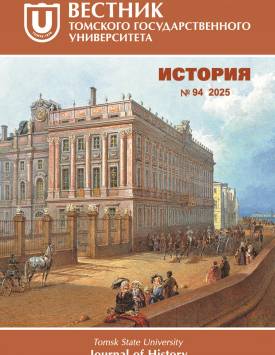Reorganization of the agricultural sector of the economy as a decisive factor in the transformation of the toponymic system of the Tom river basin in the 1920s–1970s
In this article the author analyzes the transformation of the toponymic system of the Tom river basin in the 1920s - 1970s under the influence of various socio-cultural and political-ideological factors, among which collectivization, enlargement of collective farms, liquidation of unpromising villages are singled out as the most significant and decisive. When studying sociocultural processes, including the reorganization of agriculture, the author considers it necessary to use interdisciplinary methods and approaches, in particular, toponymy data for the analysis of information and indepth study of processes on the basis of specific numerical indicators, which corresponds to the general orientation of historical science at present on the search for new sources of information and relevant methods of work. In order to achieve the research goal, namely, to determine the root causes of destructive trends in the agrarian sector and the destruction of the toponymic system in qualitative and quantitative terms, it is necessary to apply comparative-historical, historical-genetic, structural-diachronic, systemic and content analysis, since toponymy has been constantly changing in historical retrospect. There are many toponymic systems, from regional to global, and they all differ from each other. The toponymic system of the Tom river basin is, first of all, a system that has its own principles of organization and constituent elements. At different chronological stages, the toponymic system is largely transformed qualitatively and quantitatively, so it is important to take into account such changes. In addition, the author identifies destructive trends in the toponymic system of the Tom River basin, their root causes and consequences for toponymy. Since toponymy is an indicator of the nature of socio-cultural processes, their reflection, negative manifestations in social life, way of life, and economy become obvious, as these are not just names or marks on the map that appear, change, disappear, but real settlements with real people and their fates. The conclusions are based on archival materials, legislative acts, toponymic dictionaries and other sources. The paper provides numerical indicators of the disappeared, appeared, changed status (etc.) settlements located in the territory of five districts of Tomsk region and the entire territory of Kemerovo region for the whole specified period, which is the territory of the Tom river basin. The author declares no conflicts of interests.
Keywords
toponymic system, agricultural reorganization, collectivisation, consolidation of kolkhozes, liquidation of unpromising villagesAuthors
| Name | Organization | |
| Tukhel Anatoly A. | Tomsk State University | Anatoly.Tukhel@yandex.ru |
References

Reorganization of the agricultural sector of the economy as a decisive factor in the transformation of the toponymic system of the Tom river basin in the 1920s–1970s | Tomsk State University Journal of History. 2025. № 94. DOI: 10.17223/19988613/94/21
